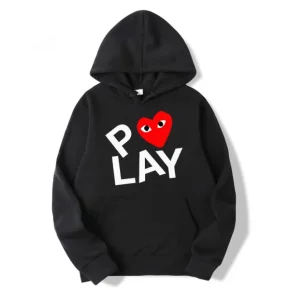Comme des Garçons, the Japanese fashion house founded by Rei Kawakubo in 1969, has consistently pushed the boundaries of contemporary fashion. Renowned for its avant-garde https://commedesgarconsco.de/ approach and refusal to conform to conventional aesthetics, Comme des Garçons has shaped not only runway trends but also the cultural understanding of style itself. What makes this brand unique is its ability to seamlessly merge conceptual art with practical wearability, allowing fashion enthusiasts to incorporate avant-garde designs into their everyday wardrobes.
The Origins of Comme des Garçons: Rei Kawakubo’s Vision
The foundation of Comme des Garçons lies in Kawakubo’s radical philosophy: fashion should challenge perceptions rather than simply decorate. When Kawakubo introduced her collections in Paris during the early 1980s, her designs were described as “anti-fashion” due to their dark tones, asymmetrical silhouettes, and deconstructed tailoring. Far from traditional luxury, Comme des Garçons sought to provoke dialogue about beauty, imperfection, and identity.
This rebellious start created a cult following, particularly among individuals seeking alternatives to polished Western luxury brands. Kawakubo’s work redefined the very meaning of avant-garde fashion, setting the tone for decades of groundbreaking collections that continue to inspire designers and creatives worldwide.
Avant-Garde Philosophy Meets Everyday Wear
While Comme des Garçons thrives on conceptual runway shows, its designs do not remain confined to high fashion stages. The brand has mastered the art of making experimental clothing accessible by offering wearable interpretations of its avant-garde aesthetics. For example, signature elements such as distressed fabrics, exaggerated silhouettes, layered proportions, and asymmetry are refined into garments that can be styled in everyday life.
By doing so, Comme des Garçons bridges the gap between the artistic and the practical. A jacket with unconventional tailoring or a pair of sneakers with unexpected textures may look experimental on the runway, but when styled simply, they become versatile statement pieces in streetwear. This philosophy makes the brand’s identity both highly artistic and deeply relevant to everyday fashion.
Breaking Traditional Norms in Fashion Design
Comme des Garçons consistently defies fashion norms. Instead of following seasonal trends, Kawakubo focuses on innovation. One season may feature clothing that appears unfinished, while another may highlight sculptural designs that challenge the very function of apparel. These artistic risks set Comme des Garçons apart from traditional fashion houses that rely heavily on predictability.
At its core, the brand embraces deconstruction and reconstruction—a method where garments are torn apart and reassembled in unconventional ways. This process reveals beauty in what is often overlooked: frayed edges, uneven cuts, and asymmetry become defining elements rather than flaws. Through this lens, Comme des Garçons makes a bold statement: imperfection can be fashionable.
Comme des Garçons and the Rise of Streetwear
In recent years, Comme des Garçons has played a pivotal role in shaping the intersection of luxury and streetwear. Collaborations with brands like Nike, Converse, and Supreme have introduced avant-garde elements to mainstream fashion. The instantly recognizable Comme des Garçons PLAY line, with its iconic heart logo designed by Filip Pagowski, became a global phenomenon, making the brand accessible to a wider audience while maintaining its signature edge.
By integrating streetwear aesthetics with high-fashion values, Comme des Garçons has influenced the way modern consumers perceive clothing. No longer confined to formalwear or couture, avant-garde fashion has found its way into casual wardrobes, sneakers, hoodies, and denim, redefining what luxury means in today’s cultural landscape.
The Power of Collaboration and Influence
One of Comme des Garçons’ greatest strengths lies in its collaborative spirit. Beyond apparel, the brand has worked across industries, from perfume and accessories to global art exhibitions. The fragrance line, with iconic scents like “Wonderwood” and “Blackpepper,” reflects the same experimental ethos as the clothing collections—complex, layered, and unconventional.
These collaborations extend Comme des Garçons’ influence into multiple cultural arenas. By engaging with artists, musicians, and other fashion designers, the brand maintains its relevance and continues to inspire creative cross-pollination. In many ways, Comme des Garçons is not only a fashion label but also a cultural movement.
Comme des Garçons in the Global Fashion Market
Despite its avant-garde roots, Comme des Garçons has managed to secure a powerful position in the global fashion industry. With flagship stores in Tokyo, Paris, New York, and London, as well as its innovative multi-brand retail concept Dover Street Market, the brand has created immersive shopping experiences that reflect its identity.
Dover Street Market, in particular, embodies Kawakubo’s vision of fashion as art installation. Each store is designed as a constantly evolving space where fashion, art, and culture collide. This retail model redefines how consumers engage with luxury fashion, offering more than just products—it offers an experience of discovery and creativity.
The Legacy of Rei Kawakubo’s Design Philosophy
Rei Kawakubo’s influence extends beyond Comme des Garçons itself. As one of the most celebrated designers of the 20th and 21st centuries, her radical perspective has shaped how the industry values creativity. She has inspired generations of designers to embrace risk-taking and to view fashion as a form of intellectual expression rather than mere commerce.
Her work has been recognized globally, most notably with the 2017 Met Gala exhibition, “Rei Kawakubo/Comme des Garçons: Art of the In-Between,” which honored her groundbreaking contributions to the world of fashion. This acknowledgment confirmed her place as not only a designer but also a visionary whose legacy will continue to impact the fashion landscape for decades to come.
Conclusion: Avant-Garde for the Everyday
Comme des Garçons embodies a unique fusion of radical design and everyday functionality. By challenging norms and blurring the line between art and fashion, the brand has created a space where avant-garde concepts are not just for the runway but for daily wear. Its ability to influence streetwear, luxury, and global culture demonstrates the timeless relevance of Rei Kawakubo’s vision.
As we continue to witness the evolution of contemporary style, Comme des Garçons remains a guiding force—reminding us that fashion is not only about clothing but about challenging perceptions, embracing individuality, and redefining beauty itself.












